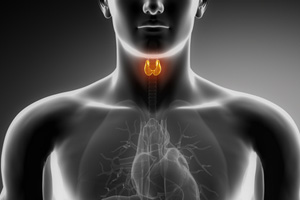CLINICIANS should take a detailed history from patients with low thyrotropin levels as alternative medicines may be the cause, according to an Australian expert on thyroid disease.
Professor Jim Stockigt, adjunct professor of medicine in the department of endocrinology and diabetes at Alfred Hospital and Monash University, said some alternative medications contained large amounts of iodine that could exacerbate any tendency towards hyperthyroidism. Stopping these medications could return thyrotropin (TSH) levels towards normal, he said.
Professor Stockigt was commenting after the publication of a study in Archives of Internal Medicine, which showed that endogenous subclinical hyperthyroidism was associated with increased risks of total and coronary heart disease (CHD) mortality and incident atrial fibrillation (AF). (1)
In the study, subclinical hyperthyroidism was defined as a thyrotropin (TSH) level lower than 0.45 mIU/L with normal free thyroxine levels, in subjects not receiving thyroid-altering medications.
The study, which included data on more than 50 000 people pooled from 10 cohorts around the world, including WA’s Busselton Health Study, found that subclinical hyperthyroidism was associated with a 24% increase in total mortality, a 29% increase in CHD mortality, a 21% increase in CHD events and a 68% increase in AF.
The highest risks of CHD mortality and AF occurred in subjects whose thyrotropin levels were below 0.10 mIU/L.
In discussing their study, the authors said that, while it appeared to confirm a link between subclinical hyperthyroidism, and all-cause and cardiovascular mortality, the study was observational so should be interpreted with “great caution for clinical practice”.
Professor Stockigt said the area of subclinical hyperthyroidism was “rather confused” as there was no universal definition of what constituted suppressed thyrotropin levels.
He said his definition of “suppressed” was when TSH levels were close to zero or undetectable, but sometimes the definition was broadened to include TSH levels in the subnormal-detectable range. This definition included milder cases, many of which returned to normal TSH levels on follow-up.
“Current thyroid testing allows detection of marginal abnormalities before they become clinically apparent, which invites premature intervention and can create unnecessary anxiety”, Professor Stockigt said.
“The question is how to treat. I am not in favour of antithyroid medications in patients who have no symptoms at all. The need for treatment is not urgent, the medications do have side-effects, follow-up is entirely dependent on lab tests and the abnormality may be transient, especially around pregnancy.
“To consider treatment we need to show a persistent abnormality for at least 6 months. If that is the case, I prefer a conservative dose of radioiodine to antithyroid drugs.”
Associate Professor John Walsh, a coauthor of the Archives of Internal Medicine study, said that until this study there had been uncertainty about risk factors.
“For older patients with TSH less than 0.10 mIU/L, they should be treated with antithyroid medication or radioactive iodine”, said Professor Walsh, an endocrinologist based at the University of WA. However, he said the relative risks found in the study were across all age groups.
“Those with [levels at] 0.1 to 0.45 sometimes revert back to normal, so don’t need treatment. Generally it’s best to watch and review”, he said.
He agreed with Professor Stockigt regarding alternative medicines — particularly those with kelp and other iodine-containing substances — which he said were offered by alternative practitioners for any thyroid problems and could cause overt hyperthyroidism in some patients.
Professor Walsh also agreed with a commentary in the same issue of the Archives of Internal Medicine, which said that the results of the study provided sufficient evidence to consider treatment of subclinical hyperthyroidism, especially in elderly patients with cardiac risks, hyperthyroid symptoms or osteoporosis. (2)
The editorial said US guidelines on hyperthyroidism and other causes of thyrotoxicosis provided an indication of if and when treatment was necessary. (3)
– Kath Ryan
1. Arch Int Med 2012; Online 23 April
2. Arch Int Med 2012; Online 23 April
3. Hyperthyroidism and Other Causes of Thyrotoxicosis: Management Guidelines of the American Thyroid Association and American Association of Clinical Endocrinologists 2011
Posted 30 April 2012

 more_vert
more_vert
The evience that subclinical hyperthyroidism may be a risk factor for vascular disease has been around for a period of time. This large study provides further evidence. Before embarking on further investigations a good nutritional history should be taken. This should include the ingestion of seaweed, kelp, sushi, multivitamins, and other alternate or complementary therapies. In addition, a good history to make certain that the patient has not been exposed to radiodinated contrast agents or amiodarone is also essential. Finally, the use of betadine antiseptics, either on the skin or as a gargle also needs to be explored with the patient. Each of these compounds are a common and large source of iodine which may lead to subacute and in predisposed individuals to overt hyperthyroidism.